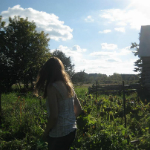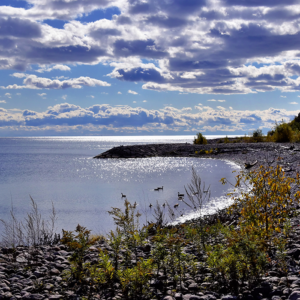Putting the Blue back into the Rouge

Blair Scott,
Professional Writing Intern
The tale of the Eastern Bluebird teaches us that species at risk can be rehabilitated if the will is there. From the 1920s to the 1970s, Eastern Bluebird populations declined dramatically. Once a regular visitor to the Rouge Valley in the eastern Greater Toronto Region, sightings of this species have been rare since then.
The Eastern Bluebird is a small, plump bird dressed in beautiful, blue plumage, accented by a rusty-orange and white chest. Its round head and stout stature is comically contrasted by its short legs and beak. It often sits perched on branches, posts or wires, examining the ground for insects on which it preys. During the off-season, it forages for berries on trees. The Eastern Bluebird depends on pre-made cavities as nests – any old hole in a dead, upright tree will do, including those made by woodpeckers.
However, it is this very dependence that has strongly impacted its survival here.
In the early 20th century, non-native birds such as House Sparrows were introduced into Canada. House Sparrows are aggressive compared to Eastern Bluebirds and also depend on nesting cavities. House Sparrows take over nesting boxes designated for Bluebirds and vigilantly defend them against interlopers. The Tree Swallow is another species that competes aggressively with the Eastern Bluebird.
Habitat loss and toxic chemicals such as DDT have also been challenges for the Eastern Bluebird. DDT spraying has long since discontinued, but other toxic chemicals are still present in the air, soil and water of the Rouge Valley. Loss of habitat remains an ongoing concern. For example, standing dead trees and rotting logs provide habitat for this species; but the human compulsion to cut down such trees and clean up “messes” of rotten wood runs counter to the interests of bluebirds.
For Eastern Bluebird conservation—if not ecological integrity generally — perhaps dead trees should be allowed to stand (until they fall down by themselves) and allowed them to rot (at their own pace) in the new Rouge National Urban Park. The park has been mentioned as one of the only places in Toronto to see bluebirds consistently, and the main reason for that is the nesting boxes provided by the Rouge Valley Conservation Center.
Nature Canada is a longtime supporter of a national park in the Rouge Valley that has ecological integrity as the first management priority—including bringing back the Eastern Bluebird. To achieve that goal; we support amendments to the Rouge Park law that the new federal government is considering. Rouge Park may be Canada’s most important urban park given that it is on the doorstep of Canada’s largest metropolitan region and includes important and rare Carolinian forests. In Rouge Park, there is nature to explore for everyone–canoeing, camping, hiking, bird-watching and fishing Get out into your NatureHood!
Nature Canada is raising our voice to have this area, as well as 6 others, listed as a protected area and you can help!
[button link=”http://e-activist.com/ea-campaign/action.retrievestaticpage.do?ea_static_page_id=4826″ size=”medium” target=”_self” color=”blue” lightbox=”false”]Take Action and Save Wilderness Now[/button]



